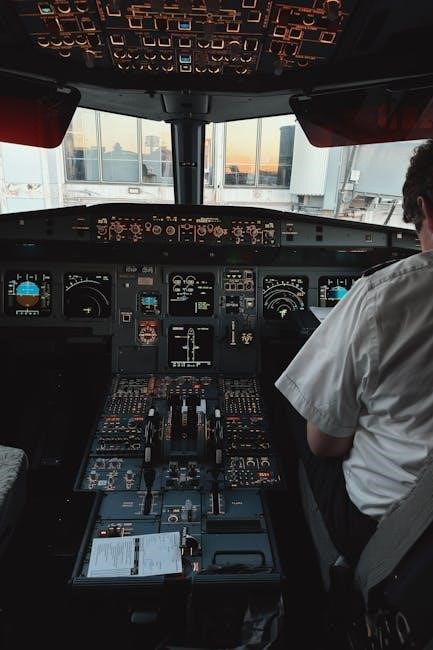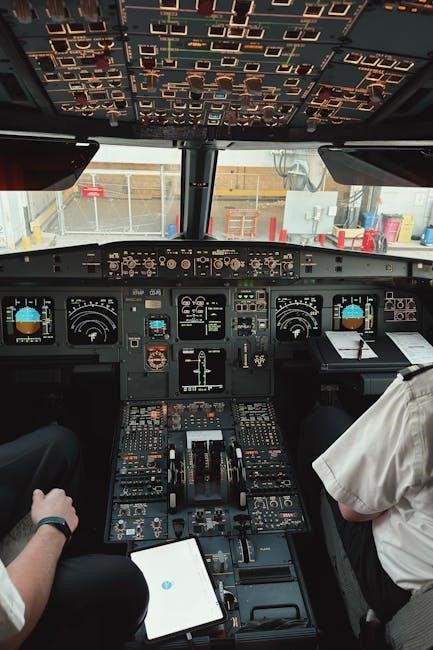A Visual Aircraft Glossary PDF is a comprehensive resource combining detailed terminology with visual aids, designed to enhance aviation education and reference. It covers historical aircraft, flight dynamics, and safety procedures, making complex concepts accessible through diagrams and illustrations. Ideal for students, professionals, and enthusiasts, this glossary bridges theory and practice, offering a user-friendly approach to understanding aviation.
1.1 Definition and Purpose
A Visual Aircraft Glossary PDF is a detailed, illustrated guide defining aviation terminology and concepts. Its purpose is to enhance understanding through visual explanations, making complex aircraft systems and flight dynamics accessible. Designed for learners, professionals, and enthusiasts, it serves as a reference tool to clarify technical terms, ensuring accurate communication and knowledge retention in aviation education and practice. The glossary bridges gaps between theory and application, fostering a deeper comprehension of aircraft operations and safety protocols.
1.2 Importance of Visual Learning in Aviation
Visual learning is crucial in aviation, where complex systems and safety rely on clear understanding. A Visual Aircraft Glossary PDF leverages images and diagrams to simplify terminology, enhancing retention and reducing errors. This method is particularly effective for explaining flight dynamics, such as lift and drag, and for illustrating aircraft components. By combining text with visuals, it caters to diverse learning styles, making aviation education more engaging and effective for students, professionals, and enthusiasts alike.

Key Components of a Visual Aircraft Glossary
A Visual Aircraft Glossary PDF includes detailed sections on aircraft parts, flight dynamics, navigation systems, and safety procedures, presented with clear visuals and concise terminology for enhanced learning.
2.1 Aircraft Parts and Terminology
The Visual Aircraft Glossary PDF provides detailed explanations of aircraft components, such as wings, engines, and cockpits, alongside terminology like “lift” and “thrust.” Visual aids, including diagrams and 3D models, help learners identify and understand each part’s function. This section also covers complex systems, such as avionics and landing gear, with clear labels and descriptions. By combining text and visuals, it ensures a comprehensive understanding of aircraft anatomy, making it easier for students and professionals to grasp aviation fundamentals effectively.
2.2 Visual Explanations of Flight Dynamics
The Visual Aircraft Glossary PDF simplifies complex flight dynamics through diagrams and infographics. It visually explains forces like lift, thrust, drag, and gravity, showing how they interact during flight. Illustrations of aerodynamic principles, such as airfoil shapes and wing angles, help learners understand how lift is generated. Real-time scenarios, like takeoff and landing, are depicted to demonstrate these concepts in action. This visual approach makes abstract ideas accessible, aiding both students and professionals in grasping the science behind flight mechanics effectively.
2.3 Navigation and Communication Systems
The Visual Aircraft Glossary PDF provides detailed visual explanations of navigation and communication systems. It includes diagrams of GPS, VOR, and ILS systems, along with illustrations of communication equipment like radios and transponders. Visual representations of approach control and visual approach slope indicators are also highlighted. These visuals help learners understand how pilots navigate and communicate effectively, ensuring safe and efficient flight operations. The glossary bridges theoretical knowledge with practical applications, making complex systems accessible to both students and professionals.
2.4 Safety Equipment and Procedures
The Visual Aircraft Glossary PDF extensively covers safety equipment and procedures with clear visuals. It includes detailed illustrations of emergency exits, fire extinguishers, and oxygen masks. Visual representations of evacuation procedures and emergency landing protocols are also provided. The glossary explains safety checks and emergency communication systems, ensuring comprehensive understanding. These visuals aid in quick identification and application of safety measures, making it an invaluable resource for both professionals and students in aviation training and operations.

How to Use a Visual Aircraft Glossary Effectively
A Visual Aircraft Glossary PDF enhances learning by combining images with definitions, making complex aviation concepts easier to understand. It serves as a quick reference guide for students, professionals, and enthusiasts, fostering visual learning and retention of key terminology and procedures.
3.1 Tips for Learners and Students
Learners can maximize the Visual Aircraft Glossary PDF by using its visual aids to reinforce textbook concepts. Start with key terminology, cross-reference diagrams for better understanding, and focus on practical applications. Regular review of flight dynamics and safety procedures ensures retention. Utilize the glossary as a study guide before exams or training sessions. Its visual format makes complex aviation principles more engaging and accessible, helping learners grasp difficult topics efficiently.
3.2 Strategies for Educators and Instructors
Educators can effectively integrate the Visual Aircraft Glossary PDF into lesson plans by emphasizing its visual aids to explain complex aviation concepts. Encourage interactive learning by assigning students to identify and label aircraft parts using the glossary. Incorporate real-world scenarios to demonstrate practical applications of terminology. Regular quizzes and group discussions can reinforce understanding. The glossary’s visual format allows instructors to create engaging presentations, making aviation education more accessible and dynamic for students of all learning styles.
3.3 Practical Applications for Professionals
The Visual Aircraft Glossary PDF serves as an invaluable tool for aviation professionals, offering quick access to detailed terminology and visual explanations. Pilots can use it to review flight dynamics and navigation systems pre-flight, while maintenance crews can reference safety equipment and procedures. Engineers benefit from clear diagrams of aircraft parts and systems. Its practical format ensures professionals can efficiently troubleshoot and stay updated on industry standards, making it an essential resource for real-world applications in aviation.

Historical Development of Aircraft Glossaries
The Visual Aircraft Glossary PDF traces its roots to early aviation terminology, evolving from text-based lists to include visual aids. Historical documents, like the WWII Aircraft Glossary, highlight this transformation, providing a foundation for modern, visually enhanced resources that aid in understanding aircraft systems and flight dynamics.
4.1 Early Aviation Terminology
Early aviation terminology laid the foundation for modern aircraft glossaries, focusing on basic flight concepts and mechanical components. Pioneers like the Wright Brothers introduced terms such as “airspeed” and “altitude,” which became essential for communication. These early terms were often simple yet precise, enabling the standardization of language across the emerging aviation industry. The development of visual aids, such as diagrams, soon followed, enhancing the understanding of complex systems. This period marked the beginning of a structured approach to aviation terminology, paving the way for comprehensive visual glossaries.
4.2 Evolution of Visual Learning Tools
The evolution of visual learning tools in aviation has transformed how complex concepts are understood. From static diagrams to interactive 3D models, these tools now offer dynamic representations of aircraft systems and flight mechanics. Modern visual aids incorporate real-time data and simulations, enhancing engagement and comprehension. This shift reflects advancements in technology and the growing recognition of visual learning as a critical component of aviation education and training, making it more accessible and effective for diverse learners.
4.3 WWII Aircraft Glossary as a Reference
The WWII Aircraft Glossary serves as a valuable historical reference, offering insights into the terminology and technology of World War II aviation. Available as a free PDF download, it provides detailed descriptions of aircraft parts, systems, and operational procedures. This resource is particularly useful for historians, enthusiasts, and educators seeking to understand the evolution of aviation terminology. Its structured format and visual explanations make it an accessible tool for exploring the technical aspects of historic aircraft, bridging the gap between past and present aviation knowledge.

The Science Behind Flight Explained Visually

The science behind flight is vividly illustrated through diagrams and visuals, explaining forces like lift, thrust, drag, and gravity. These visual explanations simplify complex aerodynamic principles, aiding learners in grasping flight mechanics intuitively.
5.1 Forces Acting on an Aircraft
The Visual Aircraft Glossary PDF explains the four fundamental forces acting on an aircraft: lift, thrust, drag, and gravity. These forces are visually represented through diagrams, showing how they interact during flight. Lift, generated by wings, counteracts gravity, while thrust from engines overcomes drag. Visual aids, such as force vectors and graphs, help learners understand how these forces balance and influence an aircraft’s motion. This section is crucial for grasping aerodynamic principles and how they apply to real-world aviation scenarios.
5.2 Aerodynamic Principles
The Visual Aircraft Glossary PDF visually explains key aerodynamic principles, such as airflow dynamics, airfoil shapes, and Bernoulli’s principle. It illustrates how wing designs generate lift and reduce drag, using diagrams to show pressure distribution and airflow patterns. Visual representations of concepts like laminar flow, turbulence, and stall conditions help learners grasp complex aerodynamic behaviors. These visuals, combined with clear definitions, make the principles accessible for both students and professionals, enhancing understanding of how aircraft interact with the atmosphere during flight.
5.3 Visual Representations of Flight Mechanics
The Visual Aircraft Glossary PDF employs detailed diagrams and illustrations to explain flight mechanics, such as lift, thrust, drag, and weight. Visualizations of airflow patterns, angle of attack, and wingtip vortices provide clarity. Real-world scenarios, like takeoff and landing, are depicted to demonstrate how these forces interact. These visual aids simplify complex concepts, making them easier to understand and apply in practical aviation contexts, whether for training, maintenance, or operational purposes.
Downloading and Accessing the Visual Aircraft Glossary PDF
The Visual Aircraft Glossary PDF can be downloaded from reliable aviation websites or educational platforms. Ensure the source is credible for accurate information. Use bookmarks and search features for easy navigation, allowing quick access to specific terms or sections. This resource is ideal for offline study, offering a comprehensive guide to aircraft terminology and visuals anytime, anywhere.
6.1 Reliable Sources for Download
Obtaining the Visual Aircraft Glossary PDF from reputable sources ensures accuracy and reliability. Official aviation websites, educational institutions, and recognized aviation publishers are ideal platforms for downloading. Look for sources like the WWII Aircraft Glossary PDF, which offers historical and technical insights. Additionally, aviation training portals and trusted e-learning platforms provide verified content. Always verify the authenticity of the source to avoid outdated or incorrect information, ensuring a seamless and enriching learning experience for aviation enthusiasts and professionals alike.
6.2 Tips for Effective PDF Navigation

Mastering the Visual Aircraft Glossary PDF requires efficient navigation. Use bookmarks to quickly access sections like aircraft parts or flight dynamics. Employ the search function to find specific terms or concepts instantly. Zoom in on detailed diagrams for clarity and take notes using annotation tools. For offline use, print relevant pages or save sections for later reference. Familiarize yourself with the table of contents to streamline your learning process and maximize the resource’s educational potential effectively.
Visual Aids in Aviation Education
Visual aids like diagrams, illustrations, and infographics simplify complex aviation concepts, such as lift, thrust, and drag, making them easier to understand and retain for learners.
7.1 Diagrams and Illustrations
Diagrams and illustrations in the Visual Aircraft Glossary PDF provide clear, detailed visuals of aircraft components, such as wings, engines, and cockpits. These visuals aid in understanding complex aviation concepts, like lift generation and control surfaces. Labeled diagrams ensure learners can identify and memorize parts effectively. Color-coded illustrations highlight key systems, making the content engaging and accessible for both students and professionals. This visual approach enhances retention and practical application, bridging the gap between theoretical knowledge and real-world aviation practices.
7.2 Infographics and Charts
Infographics and charts in the Visual Aircraft Glossary PDF simplify complex aviation data, such as flight dynamics and performance metrics. These visuals present information like thrust, drag, and lift in an organized manner, making key concepts easier to grasp. Charts compare aircraft specifications, while infographics highlight safety procedures and system interactions. This format enables quick reference and enhances learning for students, professionals, and enthusiasts, ensuring practical applications and deeper understanding of aviation principles. Visual data organization is crucial for effective knowledge retention and real-world application.
7.3 Real-World Applications
The Visual Aircraft Glossary PDF is invaluable for real-world applications, aiding pilots in pre-flight checks and in-flight decision-making. Maintenance crews use it to identify and repair aircraft parts efficiently. Educators integrate it into training programs to enhance practical understanding. Enthusiasts and hobbyists benefit from its detailed visuals and terminology, making it a versatile tool for aviation professionals and enthusiasts alike. Its practical applications ensure it remains a go-to resource for hands-on learning and professional development in the aviation field.
Comparing with Other Aviation Glossaries
The Visual Aircraft Glossary PDF stands out by combining detailed visuals with terminology, offering a more engaging and accessible learning experience compared to traditional text-based glossaries.
8.1 Text-Based vs. Visual Glossaries
A Visual Aircraft Glossary PDF surpasses traditional text-based glossaries by integrating images, diagrams, and illustrations. While text-based resources rely solely on written descriptions, visual glossaries enhance understanding through engaging, interactive content. This approach simplifies complex aviation concepts, making them more accessible for learners. Visual aids like diagrams of aircraft parts and flight dynamics provide clarity, reducing reliance on lengthy explanations. This format is particularly beneficial for visual learners, ensuring a more effective and engaging educational experience in aviation studies and professional training.
8.2 Specialized vs. General Aviation Glossaries
A Visual Aircraft Glossary PDF can be tailored for specific or broad audiences. Specialized glossaries focus on niche areas, such as WWII aircraft or modern engineering, offering in-depth terminology. General glossaries provide a broader overview, covering basic aviation concepts for students and enthusiasts. While specialized versions cater to professionals needing detailed technical language, general ones ensure accessibility for newcomers. Both formats leverage visual aids, but specialized glossaries often include rare or historical terms, making them invaluable for experts seeking precise information in their field of study or work.

Real-World Applications of the Glossary

The Visual Aircraft Glossary PDF is a practical tool for pilots, maintenance professionals, and enthusiasts. It aids in understanding aircraft systems, historical planes, and visual flight rules, making it essential for real-world applications in aviation.
9.1 For Pilots and Aviation Professionals
The Visual Aircraft Glossary PDF serves as an invaluable resource for pilots and aviation professionals, offering clear visual explanations of flight dynamics, aircraft parts, and safety procedures. It aids in understanding complex aviation terminology, such as lift, thrust, and drag, while providing historical context, like WWII aircraft references. This tool enhances training, quick reference, and real-world applications, ensuring professionals can operate safely and efficiently. Its visual approach simplifies learning and application, making it essential for modern aviation practices.
9.2 For Aircraft Maintenance and Engineering
The Visual Aircraft Glossary PDF is a vital tool for aircraft maintenance and engineering professionals, providing detailed visual explanations of aircraft components and systems. It includes diagrams of flight dynamics, safety equipment, and historical references, such as WWII aircraft terminology. This resource aids in troubleshooting, understanding aerodynamic principles, and ensuring compliance with aviation standards. By visually representing complex engineering concepts, it streamlines maintenance processes and enhances technical understanding, making it indispensable for professionals in the field.
9.3 For Aviation Enthusiasts and Hobbyists
The Visual Aircraft Glossary PDF is a valuable resource for aviation enthusiasts and hobbyists, offering a detailed visual guide to aircraft terminology and history. It includes diagrams of historical planes, such as WWII aircraft, and explanations of flight dynamics, making complex concepts engaging and accessible. This glossary fosters a deeper appreciation for aviation, allowing enthusiasts to explore aircraft design, safety procedures, and aerodynamic principles through clear visuals and concise descriptions, enhancing their hobby and knowledge pursuit.

Future Trends in Visual Aircraft Glossaries
Future trends include digital evolution, interactivity, and integration with modern learning platforms. Enhanced with AR/VR, these glossaries will offer immersive, real-time visual learning experiences for aviation enthusiasts and professionals.
10.1 Digital Evolution and Interactivity
The digital evolution of visual aircraft glossaries is transforming learning through interactivity. Advanced features like AR/VR enable immersive exploration of 3D aircraft models and real-time simulations. Interactive diagrams and gamification elements enhance engagement, while cloud-based platforms allow seamless access. These tools provide personalized learning experiences, enabling users to explore complex aviation concepts dynamically. Regular updates ensure content stays relevant, making these glossaries indispensable for modern aviation education and professional training.
10.2 Integration with Modern Learning Platforms
Modern learning platforms now seamlessly integrate with visual aircraft glossaries, enhancing accessibility and engagement. These platforms support interactive content, quizzes, and simulations, making learning dynamic. Institutions can embed glossaries into their LMS, ensuring synchronized access. Real-time updates and personalized learning paths further enrich the experience, catering to diverse user needs. This integration fosters a cohesive educational environment, bridging visual and theoretical knowledge for aviation professionals and students alike, while ensuring up-to-date information and enhanced learning outcomes.
